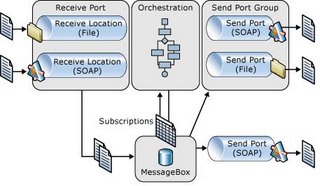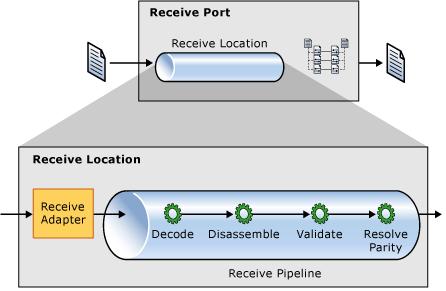As Biztalk Server 2006 is released, let's look at its architecture for an example of SOA.

Biztalk server includes four parts: Receive Port, Message Box, Orchestration, and Send Port. Receive Port uses protocol (FTP, SOAP, etc.) specific Adpater to receive file or message, then persists the (transformed) message into Message Box. Message Box activates according Orchestration or Send Port based on subscription of the message type. Orchestration is a process workflow to do some work based on incoming message, then Orchestration may persist a new message in Message Box. Message Box activates according Send Port to send the new message out.
From the architecture, we can know that Biztalk server is in message-based. Its main function is to receive a message, and to send message after doing some work. You can also take Biztalk as a message processing service.
For development, Biztalk developers typically start by modeling the messages using XML schema. Developers then promote several message properties for routing purposes. Then Developers configure Orchtestration or Send Ports to subscribe the messages matching those promoted properties. The orchestration developed also deals with XML schema to process message. From these steps, you can see it is a contract-first development.
Biztalk application is also autonomous. Biztalk does not care about the implementation details of other connected applications. It only cares the messages received/sent using the predefined XML schema.
Until now, you can say Biztalk is a good example of Service-Oriented application. Is it a web service? No, although you can optionally publish an orchestration as a web service.
Biztalk architecture allows flexibility to connect to nearly any kind of legacy applications by using different Adapter in receive/send port. Let's take receive port as an example:

The receive port uses protocol-specific Adpater to receive original message and add other context information to build an internal message, then the pipeline can decode the message, the last step in receive port is XML schema mapping to transform the original message into another format that Orchestration knows.
Developers can use many kinds of Adapter to receive/send message, e.g. using MSMQ, SOAP, even Windows Communication Foundation Adapter. This architecture allows to integrate various applications without modifying those applications' code.
Wrap-Up
Biztalk is a good example of Service-Oriented Architecture application. The architecture uses contract-first development and allows potential extension.
0 comments:
Post a Comment